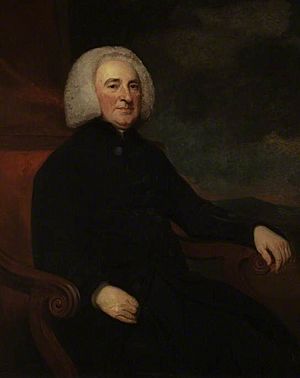Charles Moss (bishop of Bath and Wells) facts for kids
Quick facts for kids The Right Reverend Charles Moss |
|
|---|---|
| Bishop of Bath and Wells | |
 |
|
| Church | Church of England |
| Province | Canterbury |
| Diocese | Bath and Wells |
| Elected | 1774 |
| Reign ended | 1802 |
| Predecessor | Edward Willes |
| Successor | Richard Beadon |
| Other posts | Bishop of St David's (1766–1774); Chaplain to the King (1758–1766) |
| Personal details | |
| Born | 3 January 1712 Postwick, Norfolk |
| Died | 13 April 1802 (aged 90) London |
| Buried | Grosvenor Chapel |
| Denomination | Anglican |
| Alma mater | Caius College, Cambridge |
Charles Moss (born January 3, 1712, died April 13, 1802) was an important leader in the Church of England. He served as a bishop in two different areas: first as the Bishop of St David's from 1766 to 1774, and then as the Bishop of Bath and Wells from 1774 until his death in 1802.
Contents
A Life of Service
Early Life and Education
Charles Moss was born in a place called Postwick, in Norfolk, England. His father, William Moss, was a successful farmer and owned a lot of land. Charles went to Norwich School and then studied at Gonville and Caius College, Cambridge. He earned his first degree in 1731. In 1737, he became a priest, which is called being ordained. He was also a fellow (a senior member) at Caius College from 1735 to 1739.
Important Church Roles
Over the years, Charles Moss held many important positions in the church. He was a prebendary (a type of church official) in different places like Warminster and Hurstbourne. He also served as a canon (another church official) in Salisbury. From 1749 to 1766, he was the Archdeacon of Colchester at St. Paul's Cathedral in London.
In 1752, Charles Moss was chosen to be a Fellow of the Royal Society. This is a very old and respected group for scientists. He even served as their vice-president for a few years.
Serving the King and as Bishop
From 1758 to 1766, Charles Moss was a Chaplain to the King. This meant he was a special priest who advised the King. In 1759, he became the rector (the main priest) of St George's, Hanover Square, a famous church in London.
In 1766, he was appointed the Bishop of St David's in Wales. A bishop is a high-ranking leader in the church who oversees a specific area called a diocese. He stayed in this role until 1774.
Later in 1774, he became the Bishop of Bath and Wells, a diocese in England. He held this important position until he passed away in 1802.
A Special Ceremony
In 1787, as the Bishop of Bath and Wells, Charles Moss took part in a very special ceremony. He was one of three bishops who consecrated (officially made them bishops) William White and Samuel Provoost. These two men became the second and third American Episcopal bishops. This was an important moment for the church in the newly formed United States.
Charles Moss died in London and was buried at Grosvenor Chapel.
His Family
Charles Moss was married to Mary, who was the daughter of Sir Thomas Hales. They had a daughter and a son who survived him.
He left a large amount of money when he died. He gave a good portion to his only daughter, who was married to a man named John King. The rest of his money went to his only surviving son, Dr. Charles Moss.
His son, Charles Moss, also followed in his father's footsteps. He studied at Christ Church, Oxford and became a priest. His father helped him get several important church roles, including Archdeacon of Carmarthen and Archdeacon of St. David's. He also became a sub-dean and precentor at Wells Cathedral. In 1807, his son also became a bishop, serving as the Bishop of Oxford.

